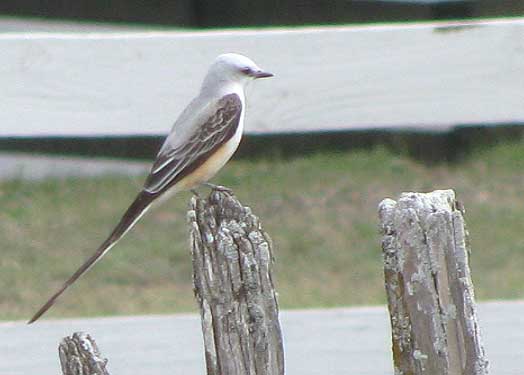Excerpts from Jim Conrad's
Naturalist Newsletter
from the April 21, 2013 Newsletter issued from the Frio Canyon Nature Education Center in northern Uvalde County, southwestern Texas, on the southern border of the Edwards Plateau; elevation ~1750m (~5750 ft); N29.62°, W99.86°; USA
SCISSOR-TAILED FLYCATCHER
Hot wind gushing up from Mexico's Chihuahuan Desert, dust and sweat stinging the eyes, glaring sunlight, wind beating the ears, and then this buoyant kite, silvery like a fleck of dusty sky that mid-afternoon suddenly landing on a fencepost, the kite tail trailing in the wind, and you can see exactly what it looked like below:

It's the first Scissor-tailed Flycatcher, TYRANNUS FORFICATUS, I've seen since arriving here, a young one with a long tail not nearly as long as an adult's, and pinkish sides not nearly as pink as an adult's. He's a bird with some kind of looking-the-place-over look in his face, and I hope he liked what he was seeing, for beholding Scissor-tailed Flycatchers floating in the wind of hot summer days is a pleasure.
But, the young bird seemed unimpressed, half-wearily flying into the wind a bit before swooping to snap a bug in midair, then landing on another fencepost farther away.
Well, good luck to him, wherever he decides to spend the summer.
Scissor-tailed Flycatchers nest in the south-central US from southern Nebraska south into northern Mexico, and overwinter from southern Mexico through Central America, on the arid Pacific slope, to Panama. The species may be expanding its distribution because of forest clearing on both breeding and wintering grounds.
from the April 6, 2014 Newsletter issued from the Frio Canyon Nature Education Center in the valley of the Dry Frio River in northern Uvalde County, southwestern Texas, on the southern border of the Edwards Plateau; elevation ~1750m (~5750 ft); N29.62°, W99.86°; USA
ARRIVING IN SPRING
Lots of bird migrants have arrived in our area, but one of the most spectacular is the Scissor-tails, shown below:

On a windy afternoon with the temperature in the upper 80s, this one perched on a wind-swung wire where he could overlook a big wheat field. The wind moved the wheat in big, slow waves, like the ocean, and the Scissor-tail seemed to like it. Every minute or so he'd fly out over the wheat, spreading his tail into a wide V. That would have made a fine picture, but he was too fast for me.